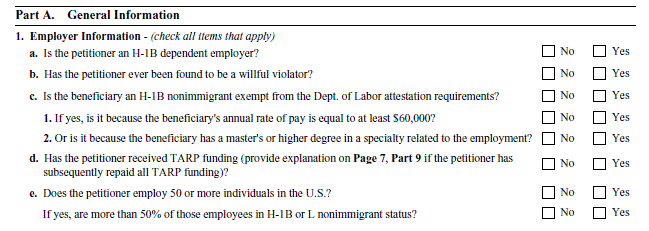
New I-129 Taunts Consulting Firms
On November 23, 2010 USCIS released a new form I-129 that will become mandatory on December 23, 2010. While the form has many new interesting features, the most notable is the effect on the nation's thriving business and IT consulting firms that place H-1B and L-1 workers at client worksites. We believe that litigation may arise over the definition of "employer" in the actual wage requirement between the Department of Labor and business and IT consulting companies that place H-1B workers at client company worksites.
The Actual Wage Problem
The actual wage is defined at 20 CFR 655.731(a)(1) as:
The wage rate paid by the employer to all other individuals with similar experience and qualifications for the specific employment in question. In determining such wage level, the following factors may be considered: experience, qualifications, education, job responsibility and function, specialized knowledge, and other legitimate business factors.
In January 2010, USCIS waded into the question of which company is the employer, the consulting/staffing firm, or its client company. For a discussion of the January 8, 2010 USCIS memo by Donald Neufeld addressing this issue, click here. To read the USCIS memo itself, click here.
The Practical Problem of Only Counting the Petitioner's Employees at a Third Party Worksite
Whether the government will litigate this position remains to be seen. But the policy problem facing the Department of Labor is that by counting only the consulting/staffing company's employees, it allows large companies to evade the actual wage requirement by indirectly employing H-1B workers. Suppose, for example, that a large database software company called MondoBase wanted to hire 1,000 H-1B workers and pay them about 20% less than simiarly employed US workers. It would be illegal to do this directly. But if they engage a third-party firm that pays its workers 20% less, it becomes legal because the third-party firm can pay its H-1B workers 20% less than MondoBase and still pay them at a rate equal to the actual wage that it is paying its own "similarly employed" workers placed at MondoBase, even if MondoBase pays its similarly employed workers at the same worksite 20% more.
The unfortunate snag is that consulting and staffing firms that pay generous wages will still face the problem of having to ask a client company for a list of its employees in jobs similar to the H-1B worker's and also ask for their actual salaries.
The new form asks specifically if the employee will work "off-site" and then also if the beneficiary will be paid the higher of the prevailing or actual wage at any and all off-site locations. The problem this poses is that to calculate the actual wage at an off-site location, which is presumably always a client company's worksite, the petitioner would need to ask the client company for a list of the wages of all similarly employed workers at that worksite working for the client company. It is unthinkable that any IT or business consulting firm placing workers at client company worksites will ask for a list of the client company's similarly employed workers at that site and their salaries. And for the business or IT company that was audacious enough to do so, it seems impossibly unlikely that the client company will release such sensitive information to an outside company.
Which "Employees" Are Counted in Actual Wages?
Employers must pay the higher of the prevailing wage and the actual wage. 20 CFR 655.731(a)(3). The two possible readings of the regulation are that: (1) the actual wage is calculated using only the wages paid to the petitioner's employees working at a specific worksite, or (2) the actual wage is calculated using the wages of all workers working at the specific worksite including the client company's employees if similarly employed.
The H-1B regulations have always required the petitioner to pay the higher of the prevailing and actual wage to the H-1B worker. The actual wage is the mean wage of similarly employed workers at the worksite where the H-1B worker will work. And subject to some exceptions, employers must file a new labor condition application when there is a material change in employment. A change in worksite location is normally a material change in employment if it is outside of he "area of intended employment."
When a New Labor Condition Application Is Required
A new labor condition application (LCA) is required when there is a material change in employment, which usually includes:
- A significant change in job duties
- Any reduction in pay regardless of amount
- A significant increase in pay
- Moving to a worksite not within the area of intended employment
- Any material increase or decrease in hours worked
Department of Labor published a good FAQ on this issue
in 2009 that you can read here
Department of Labor modified the ETA 9035 labor condition application in 2009 to require employers to list precise worksite addresses. The old ETA-9035 asked for the city and state where the worksite was located, but not the worksite address. The new form's request for worksite addresses has caused some confusion. Is a new LCA required when a worker changes worksites within the "area of intended employment" or when the worker changes worksites? What if an H-1B worker moves from one worksite to another that is within the "area of intended employment" listed on the LCA, but not a precise worksite located in the LCA?
Department of Labor has taken the position that an LCA covers work at any worksite within the area of intended employment and a new LCA is not required when moving a worker from one worksite to another within the area of intended employment. Area of intended employment is defnied as an area within normal commuting distance, which tends to be counties, but sometimes areas overlapping or within counties.
What about additional worksites outside of the LCA's area of intended employment? There are two types of worksites under the Department of Labor's labor condition application regulations: a "worksite" and a "non-worksite." If the H-1B worker will work at a non-work site, a new labor condition application is not required. The Department of Labor defines non-worksites as relating to the following employment situation:
- The job requires frequent travel to client sites or other locations and the H-1B worker does not spend more than five consecutive workdays at the same off-site worksite on any one trip;
- The H-1B worker sometimes travels to other off-site worksites, but works mostly at the worksite listed in the labor condition application and the worker does not remain at any one off-site worksite more than ten consecutive workdays on any one trip; or
- The temporary work at the third-party worksite is to attend, but give conferences, trainings, seminars or meetings.
If the H-1B employee's temporary placement at a worksite not listed in the H-1B petition does not fall into any of the "non-worksite" categories above, the H-1B employer may still be excused from filing a new LCA if the transfer qualifies as a short-term placement.
An H-1B employer may send an H-1B worker on short term projects to worksites not listed in the labor condition application. The short term projects cannot cumulatively exceed 30 days in a one year period (either the calendar year or employer's fiscal year) and the following conditions must be met:
- There is not a strike, lockout or labor dispute in the same occupation at the temporary work location;
- The employer continues to pay the H-1B employee the required wage, which is the greater of the H-1B prevailing wage at the permanent work location or the actual wage paid by the employer to similarly situated workers; and
- The employer must pay for the H-1B employee's actual costs of travel, lodging, meals and incidental expenses for weekdays and weekends.
An H-1B worker may work at locations not listed on the LCA for up to 60 days cumulatively in one year if the worker:
- Maintains a permanent office at the worksite listed in the LCA;
- Spends a substantial amount of time at the permanent work location during the one year period; and
- The worker's primary residence is in the area of the permanent work location.
If the H-1B worker's offsite assignment exceeds 30 days in the one year period (or 60 days if the worker meets the 60 day rule's requirements), the petitioner must file an amended H-1B petition with a new labor condition application. And if the H-1B worker's assignment does not qualify under one of the described above, the petitioner must file an H-1B amendment with a new labor condition application.
Overview of the New Form I-129
Important changes in the new form I-129:
- Part 5 asks specifically if the employee will work "off-site"
- Part 6 of form I-129 asks the employer to certify under penalty of perjury that it has read and reviewed the Export Administration Regulations and International Trade in Arms Regulations and determined that an export license is not required
- Part 7 signature section directs the signatory to "read the information on penalties in the instructions before completing this section"
- H Supplement Part A asks if the petitioner employs 50 or more individuals in the United States and if so whether 50% or more are H-1B or L-1 nonimmigrants
- H Supplement Part C asks the petitioner to specify which cap if any the petition should be counted against
- H Supplement Part D asks whether the beneficiary will be paid the higher of the prevailing or actual wage at any and all off-site locations
Excerpted Images of Parts of the New Form I-129
The new form I-129 H Supplement Part D asks whether the beneficiary will be paid the higher of the prevailing or actual wage at any and all off-site locations.

The new Part 6 of form I-129 asks the employer to certify under penalty of perjury that it has read and reviewed the Export Administration Regulations and International Trade in Arms Regulations and determined that an export license is not required.

The new Part 7 signature section directs the signatory to "read the information on penalties in the instructions before completing this section." The new Part 9 explanation page requires a separate signature and date to join the information to the form's perjury certification.

The new I-129 H Supplement Part A asks if the petitioner employs 50 or more individuals in the United States and if so whether 50% or more are H-1B or L-1 nonimmigrants. This welcome addition will reduce the number of requests for evidence seeking to learn the answer to this question first posed in a law signed by President Obama that became effective August 24, 2010 requiring employers who answer yes to both questions to pay an additional filing fee of $2,000 for new H-1B petitions and $2,250 for new L-1 petitions. For more on that story, please click here.

The new I-129 H Supplement Part C asks the petitioner to specify which cap if any the petition should be counted against.

visit us at:
San José, CA 95008
Santa Cruz, CA 95060
The Olender Pro Bono Project
We represent some clients who have compelling cases and little money at no charge. Sean received the Benito Juarez human rights award in 2008 and the ALRP Volunteer Award in 2012 for taking more than 10 pro bono cases in 12 months. We need volunteers. E-mail Debbie to volunteer.
Change Your Address at DHS!
If you are not a US citizen, you must change your address with DHS within 10 days of moving or face deportation. Click Here.






































